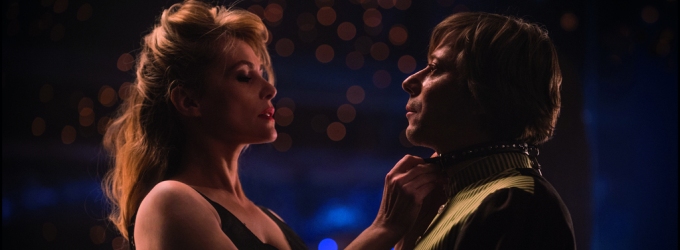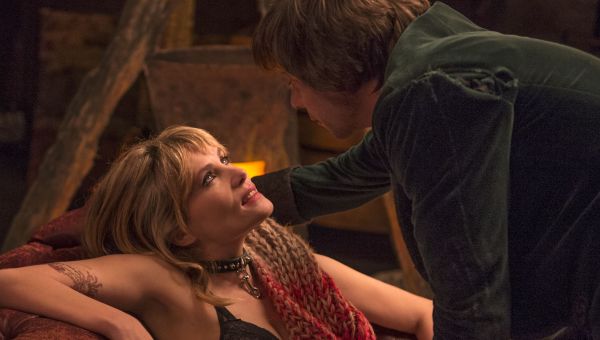 The sensual, theatrical interior of The Gate cinema, with its seating optimised for couples, is the perfect venue in which to luxuriate in the stern embrace of VENUS IN FUR (“La Vénus à la fourrure”). Roman Polanski (CHINATOWN, THE PIANIST) directs this adaptation of David Ives’ play concerning a play that adapts Sacher-Masoch’s novel for the stage. He casts his wife Emmanuelle Seigner (LA VIE EN ROSE) as jobbing actor Vanda, keen for the role of Wanda, and his near-double Mathieu Amalric (THE GRAND BUDAPEST HOTEL, COSMOPOLIS) as Thomas, a writer making his directorial debut by mounting a production of his own adaptation of the book.
The sensual, theatrical interior of The Gate cinema, with its seating optimised for couples, is the perfect venue in which to luxuriate in the stern embrace of VENUS IN FUR (“La Vénus à la fourrure”). Roman Polanski (CHINATOWN, THE PIANIST) directs this adaptation of David Ives’ play concerning a play that adapts Sacher-Masoch’s novel for the stage. He casts his wife Emmanuelle Seigner (LA VIE EN ROSE) as jobbing actor Vanda, keen for the role of Wanda, and his near-double Mathieu Amalric (THE GRAND BUDAPEST HOTEL, COSMOPOLIS) as Thomas, a writer making his directorial debut by mounting a production of his own adaptation of the book.
It is a tricky, slick double hander about actors, acting, sex, the stage, sex on stage, the power of pretending and pretending to have power. Vanda and Thomas co-opt the set of a musical adaptation of STAGECOACH (itself a film adaptation of a short story) in a run-down theatre in order to audition Vanda as Wanda. An audition which becomes rehearsal which becomes improvisation which becomes something deeper and stranger. Everything we see is a symbol for a metaphor, unless it isn’t, and the whole is, as Thomas keeps insisting of his own work, “ambiguous”, in the face of Vanda’s repeated dismissals of it as merely “ambivalent”.
Polanski lets the verbal beatings roll on while the camera caresses the characters’ clothes, faces and limbs
Ives’ own subtitles in English for this French-language film provide some important clues for the viewer trying to keep track of framing story, play-within-a-play, pretence and what might or might not be reality. The textual reflection of Vanda’s arch German accent while hamming up Wanda’s dialogue are a delight. And there are laugh-out-loud jokes scattered through the piece, verbal and physical, not least in the use made of certain fortuitously-placed elements of the STAGECOACH set. Some more intelligent plays often feature a lot of standing around and talking which rarely translates well to cinema, but Polanski lets the verbal beatings roll on while the camera caresses the characters’ clothes, faces and limbs.
The film departs from the play in some details, which make it perhaps more ambiguous (although never ambivalent). We are given to understand that through the play Thomas seeks to meet a desire within himself that has not been well received by one interested party or another. He may not even fully realise what it is himself, although he rejects Vanda’s somewhat facile Freudian picking away at his motivations.
Thomas’ desire, whatever it turns out to be, seems to summon Vanda out of the darkness around the theatre, expounding to his unseen fiancee his recipe for what he says he thinks he wants, “sexy-slash-articulate young women with some classical training and a particle of brain in their skulls”. So, Thomas, here is one: what now?
There is some delicate Foley work in the film, reminiscent of the stage show of THE WOMAN IN BLACK where the techniques by which an audience is induced to suspend disbelief are anatomised. In VENUS they serve to blur the boundaries of the play-within-the-play, fantasy leaking into an imagined reality. Seigner and Amalric deliver performances of strength and flexibility, slipping fluidly between levels of representing representation; Seigner’s seeming shedding of her years in particular is quite astonishing. Cinematic and theatrical tricks intertwine. Jokes interleave with thoughts. The audience is entertained and teased and provoked, but Vanda has come to teach Thomas a lesson, and maybe that lesson gets a little lost in the entertainment. Nevertheless, see it twice.
Keith Braithwaite and Ruth Muscat
httpvh://youtu.be/S9x6ffH188E


Nevertheless, see it twice
Once was more than sufficient : some are less impressed by the chinking of a non-existent cup ! 🙂
THE AGENT APSLEY suggests, in a review, that the non-existent cup is the furry one of Méret Oppeheim…
Oppenheim’s fur–covered cup, saucer and spoon wouldn’t chink or clink. No points, but a good effort. Thanks for playing.
A little literal in your riposte, Keith, since Oppenheim’s coffee-kit is no more, no less prone to chink than an imagined, invisible one ? – by, literally, muffling hers, Oppenheim is even, arguably, quoting Bishop Berkeley…